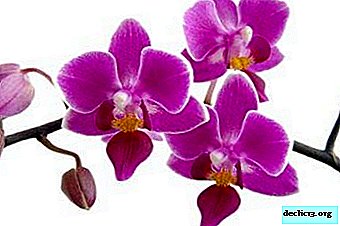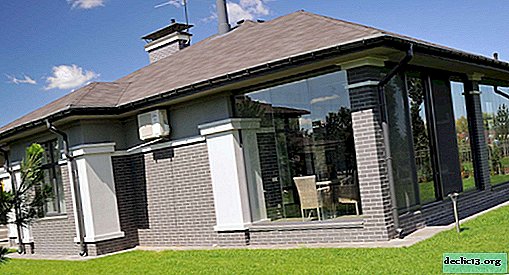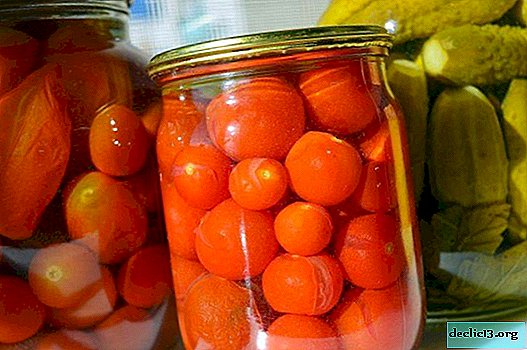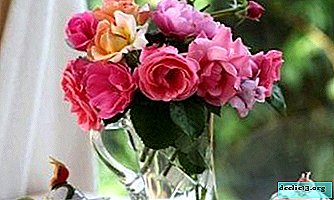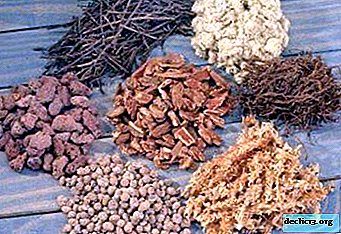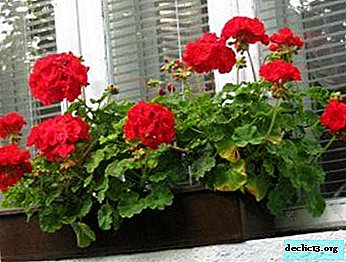Fragrant rose Lady of Shallot. Features of a flower, rules of care and growing, photo
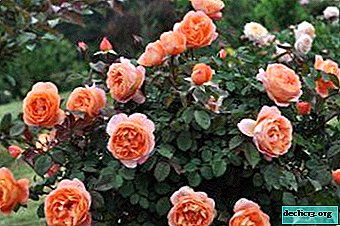
The rose, which is often recommended to beginners, as well as the rose that is most resistant to diseases and adverse weather conditions, is called the Lady of Shallot.
This fragrant beauty of golden salmon color has an excellent rating. It is recommended to grow even in a cool climate.
This article describes in detail the features of roses, the rules of care and cultivation, posted visual photos.
Description
Lady of shallot is a hardy rose. It also affects a long flowering. Delicate golden salmon buds bloom in thick double-bowl cup-shaped flowers. The pinkish petals have a golden yellow inside. On the stem there are from 1 to 3 pieces. The size of the flower is 8-10 cm. The bush grows to 120 cm in height and 100 cm in width. The variety has very good resistance to powdery mildew and black spotting and practically does not get sick. Climatic zone of frost resistance 5. Repeated flowering variety with medium aroma. Foliage from bronze grows to green.
We offer you to watch a video about the description of the rose Lady of Shallot:
Photo
Below you will see a photo of roses of this variety:




History of occurrence
Rose Lady of Shallot appeared in England in 2009 thanks to breeder David Austin. In the past, a simple English farmer, in the middle of the 20th century began to engage in the cultivation of his own varieties of roses, and now his flowers are known around the world.
What is the difference from the rest of the species?
Lady of Shallot is stamina and disease resistant. Among English roses, this variety has a wider bush (up to 100 cm).
Bloom
- When and how. The variety is re-flowering. In the summer, buds have time to appear several times.
- Care before and after flowering - features. Rose needs basic care. Features of the re-blooming Lady of Shallot is the timely pruning of faded buds.
- What to do if it does not bloom. Roses may not give buds in the first year of life. If there is no flowering in other cases, then it is worth tracking the duration of daylight hours. Does the plant remain constantly in the shade? In case of damage by pests or diseases, they must be cured. Flowering may not take place due to waterlogging or close occurrence of groundwater.
Use in landscape design
A rose of gentle tones can be used in combination with other roses. For example, with pale pink Laurent Cabrol, peach Lady Emma Hamilton, pink Lydia.
The combination of rose varieties among themselves and with other crops is an important aspect of site planning.Roses are combined with a green lawn, cereals, perennials. Directly D. Austin for landscape design recommends the following:
- A large number of varieties are appropriate when the rosary is needed for breeding and growing crops for sale.
- To make roses look spectacular, each variety is planted in small groups, approximately three copies at a distance of 0.5-0.75 m from each other. If the bushes have a vertical narrow crown, the distance can be reduced to 0.3 m.
- Austin roses of different varieties are perfectly combined with each other. The soft colors of the buds are in harmony with each other, but do not combine with cultures of colorful bright colors.
Step-by-step care instructions
Choosing a landing place
 Since the bush grows quite voluminous, when choosing a place, you need to pay attention to what will surround the rose. Other shrubs should not grow in a radius of 1-1.5 m, and tall trees are not desirable in a radius of 2.5 meters. Massive plants can take all the nutrients from the soil and not enough for the rose. The plot is selected sunny, protected from wind and drafts. The lowland in which moisture collects can ruin the plant.
Since the bush grows quite voluminous, when choosing a place, you need to pay attention to what will surround the rose. Other shrubs should not grow in a radius of 1-1.5 m, and tall trees are not desirable in a radius of 2.5 meters. Massive plants can take all the nutrients from the soil and not enough for the rose. The plot is selected sunny, protected from wind and drafts. The lowland in which moisture collects can ruin the plant.
Time
Successful will be landing in the fall or spring. In autumn, the rose should have time to take root within 1.5 months before the onset of the first frost. In spring, the plant is planted in holes prepared from autumn.
What should be the soil?
An ideal soil option is loose loam with a fertile layer of humus. Clay soils must be diluted with sand before planting, and light sandy soils with clay, peat and fertile humus. Acidic soils should be normalized with bone meal.
Landing
Rose is acquired in the form of seedlings. If the root system is with an earthen lump, then it is left and the plant is planted in a prepared hole. The vaccination site is buried in the soil by 3-6 cm.
If the seedling has an open root system, then the roots can withstand several hours in water. You can withstand them in a root growth stimulator.- When landing in a chosen place, a hole is excavated at least 60 cm deep and 40 cm wide.
- 10 cm of drainage is poured into the bottom, then organic fertilizers (compost, biohumus), then the soil.
- The seedling is placed in the middle of the pit and carefully sprinkled with water, then the bush needs to be watered and spud.
Temperature
Rose Lady of Shallot belongs to the 5th winter hardiness zone.
Watering
- Spring and fall Lady of Challotte rose is watered 1-2 times a week, approximately 10 liters per bush.
- Summer in the heat you need to water more often.
- Fall with the onset of cold weather, watering is completely stopped.
Top dressing
For abundant flowering, fertilizing 2-3 times during the vegetative period is important. Nitrogen fertilizers are applied in the spring before flowering. Before wintering, a potassium phosphorus complex is introduced in the fall. Throughout the summer period, organic fertilizers can be applied.
Weeding
Roses need careful weeding and removal of weeds, which can spend on the growth of soil nutrients. Also, loose earth, which is not populated by the roots of weeds, better allows oxygen to pass through.
Pruning
 Pruning a rose involves:
Pruning a rose involves:
- Preventative pruning is done in the fall to remove diseased or dry shoots.
- Formative. Weak forming pruning is performed after flowering. The first buds are cut, otherwise re-flowering will not occur.
In spring, you can rejuvenate an old bush older than three years. Strong trimming for shaping is appropriate in the summer.
Any manipulation should be carried out with a sharp and clean pruner.
Moving to another place
Adult plants can be transplanted in the fall or spring to a new place. The stems are trimmed as much as possible, and if it is decided to transplant in the summer, then the buds are removed.
Preparation for winter
Some gardeners do not shelter the Lady of Shallot for the winter in the fifth frost resistance zone (Middle Volga, Ural, Central European part of Russia, North-Western part of Russia). If there is a need for shelter, then it is made of non-woven covering material, polyethylene is added on top. Shrub roots spud with earth.
Step-by-step instructions on how to propagate
For Austin roses, only vegetative propagation is permissible.
Layoff method:
- in spring or summer, an annual shoot is chosen;
- an incision is made on the cortex (at the location of the kidneys);
- the shoot bends to the ground and digs in the soil;
- the seedling is periodically watered; by autumn it should take root.
Cuttings are the most affordable method of propagation.:
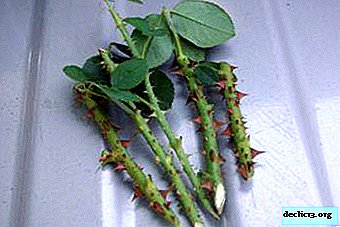 Green shoots take root faster, but woody ones are also suitable for cuttings. Cuttings are cut after flowering in the summer.
Green shoots take root faster, but woody ones are also suitable for cuttings. Cuttings are cut after flowering in the summer.- Three or more buds are left on one handle.
- The upper and lower cuts are made at an angle of 45 °.
- The blanks are deepened a few centimeters into the soil, watered as necessary, and after a month they should take root.
Diseases and Pests
The Lady of Shallot variety is resistant to powdery mildew and black spotting. Other possible diseases of roses:
- powdery mildew;
- rust;
- gray rot.
The main diseases of these flowers are precisely fungal infections. Sometimes pests hit the rose:
- a bear;
- spider mite;
- scale shield;
- pennies;
- rosette leaflet.
Rose Lady of Shallot tolerates cold, frosts up to -30 ° C. In rainy weather, the flowers do not suffer. Also, the variety is not susceptible to disease and blooms profusely. Gardeners choose this variety for beautiful and fragrant flowers that resemble the colors of dawn.

 Green shoots take root faster, but woody ones are also suitable for cuttings. Cuttings are cut after flowering in the summer.
Green shoots take root faster, but woody ones are also suitable for cuttings. Cuttings are cut after flowering in the summer.